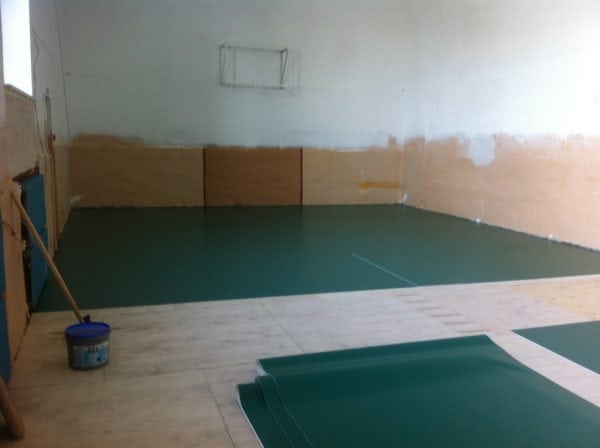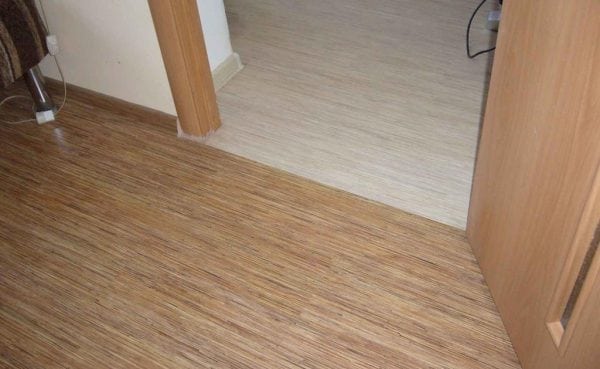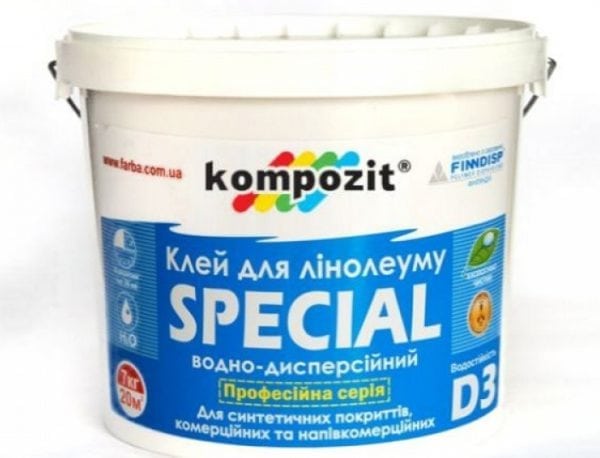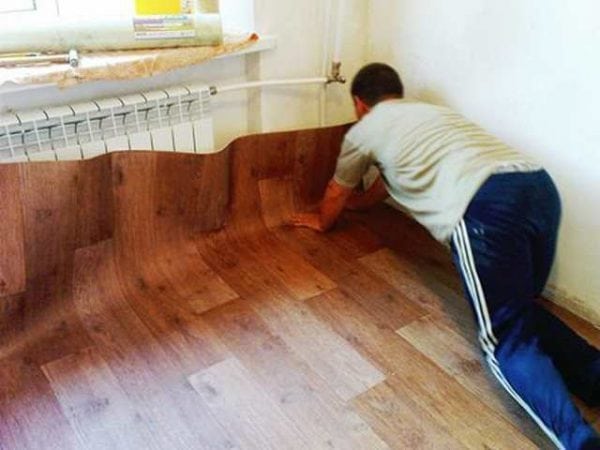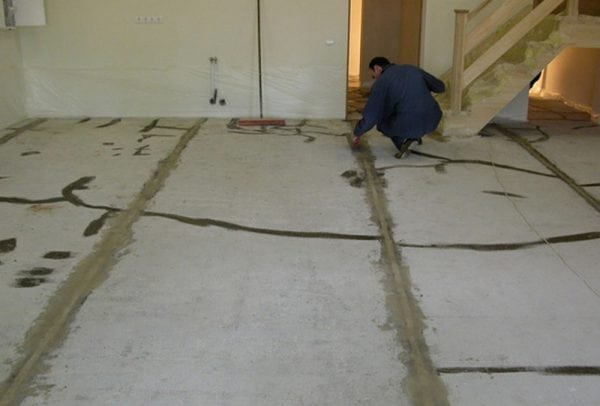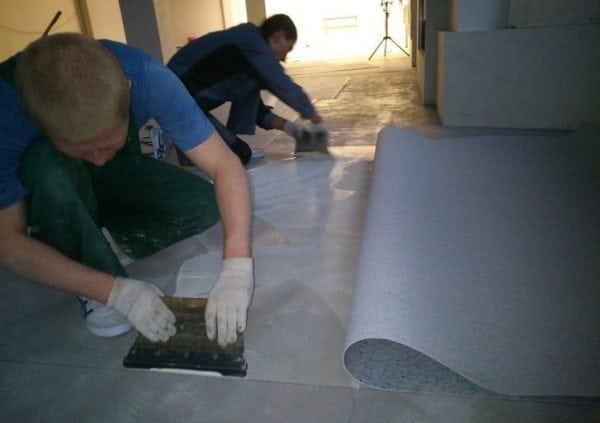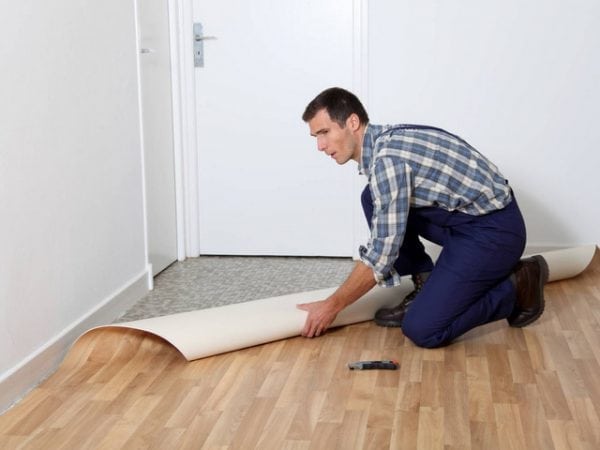Linoleum is more often than other floor coverings used at home, in offices. Its popularity is due to durability, economy, ease of installation, a variety of shades. Can linoleum be glued, is it even necessary to do this? The rules for securing the material will depend on a number of reasons.
- What affects the laying of linoleum - factors
- Why glued linoleum
- Glue selection
- Glueless laying
- Bonding technology for linoleum
- Screed mount
- Wooden laying
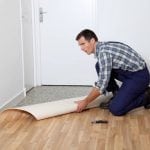
What affects the laying of linoleum - factors
Beginners in the installation of linoleum are interested in whether this material should be glued to the floor. It is quite heavy, moreover, it is laid on a concrete or other foundation in large segments. This allows you to securely fix the flooring without gluing. But in some cases, the use of adhesives is highly recommended. A number of factors determine this need:
- Large size room. If you do not stick the coating, but put it without fixing, bubbles and swellings will quickly appear.
- High loads. Material subject to daily friction, along which many move, can move. If it is glued, the styling quality will increase significantly.
- The presence of heavy furniture. When it is planned to regularly move the furniture in the room, it is better to use glue - this will prevent “wrinkles” and other defects from appearing.
Why glued linoleum
This flooring is unpretentious in leaving, but it is rather exacting to the basis. If fastening the canvas to the concrete floor, it is important to thoroughly clean it, remove all dirt and dust. You also need to lay linoleum only on a flat floor, but this is not always possible. Often on the floor there are holes, cracks, bumps. The glue will help: it will fill in the defects and serve as a leveling agent. Thus, with a moderately uneven base with small differences, the use of glue is simply necessary.
Gluing is considered to be sizing coatings in offices, especially large areas. Of course, you can throw the coating on the floor, level it, fix it with skirting boards. But regular exercise will quickly spoil the appearance of the floor. It is necessary to apply a special adhesive composition when laying linoleum, this will solve the problem.
Why else is it worth gluing the flooring? When it comes to saving, it is better to spend money and get a good glue than to skip this step. Ultimately, the flooring will last much longer. There is another plus. When glued, the joints of linoleum become almost invisible, especially when using adhesives such as "cold welding". The seams will not diverge, water will not be poured under them. Gluing also reduces the risk of dents from furniture legs.
Cons bonding material is also there. To remove the coating, you will have to make a lot of effort. It will be unsuitable for reuse - when disconnected, linoleum is torn in pieces.Low-quality glue appears on the surface, there is a risk of material damage when buying the wrong product.
to contents ↑The conclusion is: if the repair is done for many years, it is better to glue the coating. With a craving for regular repair updates, the use of glue does not make sense.
Glue selection
It’s worth buying a tool for laying flooring right away, because there are special compositions for each type of linoleum. All of them are divided into two types - reaction and dispersion. The first type of product is based on chemical components (polyurethane, epoxy resins, etc.), which react with a PVC coating, create a strong, reliable seam. You can use them with high humidity, temperature extremes, it is these tools that are called "cold welding". Dispersion adhesives are water based, environmentally friendly, odorless. They are inexpensive, but they are afraid of water and less durable. The most famous of them are acrylates, humilax, bustilate.
Glue Selection Tips:
- dispersion is worth buying for a material made on a fabric basis or with thermal insulation;
- reactionary can be purchased for full sizing of the coating, subject to strong friction, or used only at the joints;
- it is better if the product contains rubber or synthetic rubbers - such adhesives are elastic and last longer.
Glueless laying
In some cases, doubts whether or not to stick linoleum are well founded. Sometimes this should not be done. These are the following situations:
- Small room. If the room has an area of less than twenty square meters, the flooring is laid in a single piece. It is fixed along the edges with rigid skirting boards, in the area of the inter-door joint they are connected with double-sided tape, plank, “cold welding”. Bonding is not required.
- Old concrete. When the screed is loose, has a tendency to crumble, gluing will be impossible. The glue will simply leak into the screed.
- The presence of paint. Typically, the paint reacts chemically with glue, which causes stains to appear on the floor.
- Wood chip coating. Material is not glued to plywood, thin fiberboard, particleboard - this causes impregnation and deformation, delamination of the base.
- Base of parquet, laminate. It is recommended to remove the lamellas, which will diverge and begin to creak, move, which reduces the quality of the floor.
Thus, it is not necessary and even harmful to glue linoleum if the base under it is weak, non-solid, subject to displacement or destruction. It is also not recommended to stick the material only along the edges, around the perimeter or in parts. The remaining clean areas swell sooner or later, they will stick out ugly.
to contents ↑Bonding technology for linoleum
For installation, you will need the following tools:
- putty knife;
- sharp knife - construction, clerical;
- hard roller (e.g. rubber);
- roulette;
- masking tape;
- metal ruler.
It is very important to carry out a high-quality cleaning of the base before gluing the canvas. It is necessary to remove all dust, dirt, varnish, bitumen stains, soot. The tubercles and paint residues should be cleaned, because they will bulge out, especially if the linoleum is not very thick. Seams, cracks, pits are filled with silicone sealant, after drying, the excess is carefully cut off. With sharp irregularities, you will have to use special repair mixtures. Before gluing linoleum, a coating is primed, which will increase the degree of adhesion. Primer for the primer is selected taking into account good waterproofing.
At home, it is worth using dispersion glue, it is safer. If it is decided to use reaction adhesives, it is important to work with gloves, to prevent nearby sources of fire and to carefully ventilate the room.There are even special adhesives that can combine an old PVC coating with a new one. They are bought when there is no opportunity to remove worn linoleum.
to contents ↑Screed mount
Before laying linoleum, it is important to properly fit it. When the material is mounted in one piece, they begin to align it along one of the walls. As a temporary measure, you can apply double-sided tape - this will help cut the desired piece. The excess is cut with a sharp knife, leaving a gap of up to 1 cm. When laying two or more pieces, you should precisely combine the pattern - in one direction, taking into account the decor. It is also necessary to form joints. For this, the layers are laid with an overlap of 2 cm, pressed with an iron ruler, both layers are cut with a construction knife. After removing the excess, you get a smooth, precisely fitted edge.
Further, the procedure will be as follows:
- lay linoleum on the floor, if necessary, under it make a layer of insulation;
- leave for aging for a day;
- apply glue to the base, press linoleum;
- roll with a roller;
- withstand 12 hours.
Wooden laying
From a thick fiberboard you can make a good "wooden screed." Fiberboard sheets will cover all chips, bumps and pits. It is only important that the material is not thin, capable of deforming from glue. Progress is as follows:
- grind, cut off all the hillocks from the old base;
- close cracks and crevices with sealant;
- fix the fiberboard sheets with small cloves;
- cut out pieces of linoleum, lay them, leave for a day;
- apply glue abundantly on fiberboard, apply a coating;
- gently roll with a roller, dispersing bubbles and removing excess glue;
- leave for 12 hours.
Adhesive consumption is usually not high, so there will be no significant costs. But the quality of the finished coating will increase significantly, as well as its wear resistance.

